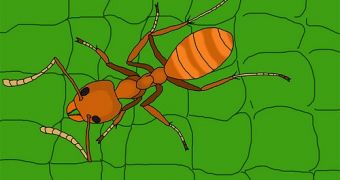University of Sydney researchers have proof that ants are quite some maths experts, being capable of solving not just complex mathematical problems, but acting like very advanced computer algorithms – adapting to a changed problem and figuring out the best solution.
This discovery reminds us that nature is very complex and that even computer programmers can learn a lot from it, and develop even better software to solve logistical problems and maximize efficiency.
Chris Reid, a doctoral student from the Behavior and Genetics of Social Insects Laboratory and lead author of this study, along with Associate Professor Madeleine Beekman from the School of Biological Sciences, working with Professor David Sumpter of Uppsala University, Sweden, used a new technique to test if the Argentine ants (Linepithema humile) could solve a dynamic optimization problem – they converted the Towers of Hanoi maths puzzle into a maze.
The researchers used the three-rod, three-disk version of the Towers of Hanoi problem, but since the ants are unable to move disks, the scientists transformed the puzzle into a maze, with the shortest path being the equivalent of the solution with fewest moves in the toy puzzle.
At the entry point in the maze, the ants had 32,768 possible paths to choose from, in order to get to the food source on the other side, with only two paths being the shortest.
The ants had one hour to solve the maze, during which they created a high traffic pathway between their nest and the food source, after which the researchers blocked the paths and opened new areas of the maze, to tests whether the ants would adapt or not.
As time was up, the ants had solved the puzzle by finding the shortest way around the edge of the maze.
When the researchers blocked the path, they chose another one, much longer than the first, still, another hour later, the ants had found the second optimal route, through the center of the maze.
The team noticed that not all the ants had equal problem solving skills – those which were allowed to explore the maze without any food for one hour before the test, made fewer mistakes and worked faster at solving it.
This observation suggests that the 'exploratory pheromone' that ants searching a new territory lay down, is their key to adapting to changing conditions.
This could be extremely helpful to humans, in finding the fastest way out of a busy network, so computer programmers need to take example from nature's ant colonies, and create the software that can find the most efficient routes under any circumstances.
For now, there is a widely used ant-inspired algorithm, that is called Ant Colony Optimization (ACO), but “although inspired by nature, these computer algorithms often do not represent the real world because they are static and designed to solve a single, unchanging problem,” explained Chris Reid.
“But nature is full of unpredictability and one solution does not fit all.
“So we turned to ants to see how well their problem solving skills respond to change.
“Are they fixed to a single solution or can they adapt?"
The researchers concluded that “even simple mass-recruiting ants have much more complex and labile problem solving skills than we ever thought.
“Contrary to previous belief, the pheromone system of ants does not mean they get stuck in a particular path and can't adapt.
“Having at least two separate pheromones gives them much more flexibility and helps them to find good solutions in a changing environment.
“Discovering how ants are able to solve dynamic problems can provide new inspiration for optimization algorithms, which in turn can lead to better problem-solving software and hence more efficiency for human industries."
These findings are published in the Journal of Experimental Biology.

 14 DAY TRIAL //
14 DAY TRIAL //